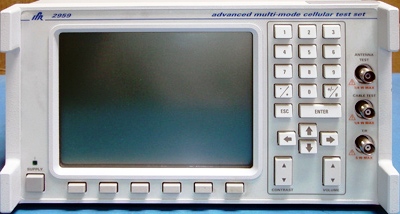
|
|
The IFR 2959 Advanced Multi-Mode Cellular Test Set allows you to perform tests manually or automatically on AMPS, NAMPS and TDMA (IS-136A) phones as well as on CDPD wireless modems. You have complete control over the entire testing process, including which tests are performed in automatic sequences and the pass/fail tolerances for each test. Multi-Mode phones can be tested in the modes disclosed to the 2959 during the Registration procedure, or individual aspects of the different modes can be tested explicitly in the manual procedures. All types of cross-mode handoffs are supported. Tests can vary from quick and simple confidence checks to comprehensive tests that disclose the causes of troublesome handset misbehavior. A rich collection of graphic displays assists in the quick and efficient identification of problems. Users can set up and store up to 10 test configurations in the 2959, while retaining factory default set up for quick tests or operator training. CDPD (Cellular Digital Packet Data) is a separate packet radio service deployed on many AMPS cellular networks. The 2959’s CDPD test mode simulates the functions of Mobile Data Base Stations (MDBS) and Mobile Data Intermediate Systems (MD-IS), which provides the stimulus and response necessary to test mobile-end systems (M-ES) often called CDPD wireless modems. Specifications. RF Signal Generator Frequency Range: 869.01 to 893 (Mobile Station Rx frequency range). Resolution: 10 kHz. Internal FM Modulation AMPS Test Tone Frequency: 1 kHz. Receiver Frequency Range: 824.01 to 848.97 MHz (Mobile Station Tx Frequency Range). Resolution: 10 kHz. Maximum Input: 5 W maximum (continuous into T/R Connector). FM Audio: -90 dBm, 12 dB SINAD. Timebase Frequency: 10 MHz nominal. Uncertainty: ±0.1 ppm. Temperature Stability: ±0.1 ppm. Ageing Rate: ±0.1 ppm/year.
|